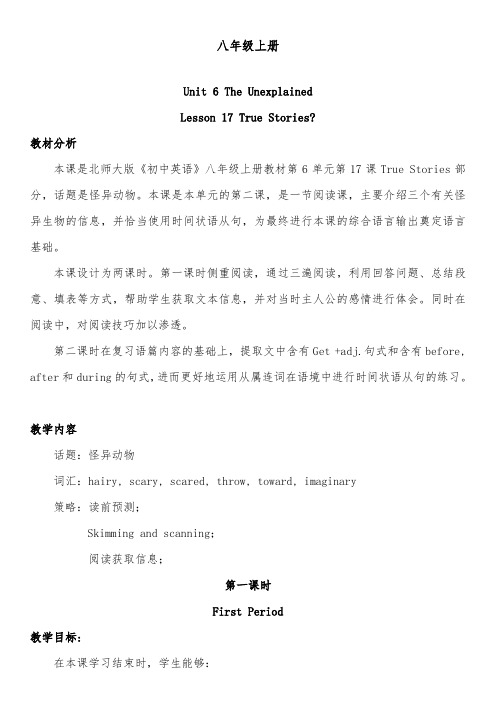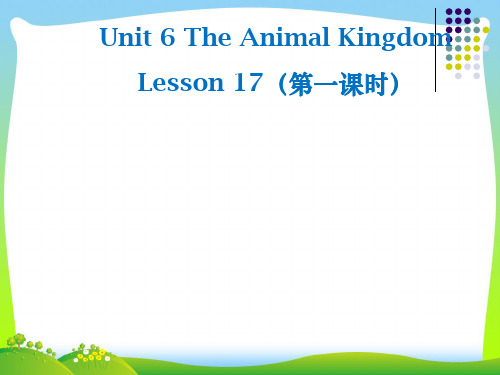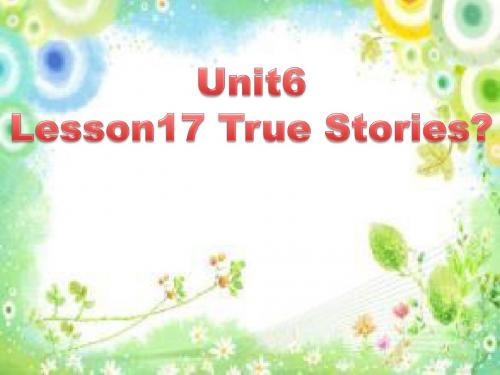Unit 6 Lesson 17 True Stories 课件3-优质公开课-北师大8上精品
- 格式:ppt
- 大小:4.20 MB
- 文档页数:26

八年级上册Unit 6 The UnexplainedLesson 17 True Stories?教材分析本课是北师大版《初中英语》八年级上册教材第6单元第17课True Stories部分,话题是怪异动物。
本课是本单元的第二课,是一节阅读课,主要介绍三个有关怪异生物的信息,并恰当使用时间状语从句,为最终进行本课的综合语言输出奠定语言基础。
本课设计为两课时。
第一课时侧重阅读,通过三遍阅读,利用回答问题、总结段意、填表等方式,帮助学生获取文本信息,并对当时主人公的感情进行体会。
同时在阅读中,对阅读技巧加以渗透。
第二课时在复习语篇内容的基础上,提取文中含有Get +adj.句式和含有before, after和during的句式,进而更好地运用从属连词在语境中进行时间状语从句的练习。
教学内容话题:怪异动物词汇:hairy, scary, scared, throw, toward, imaginary策略:读前预测;Skimming and scanning;阅读获取信息;第一课时First Period教学目标:在本课学习结束时,学生能够:1.运用形容词描述怪异的生物;2.通过阅读,获取文中三段有关怪异生物的信息;3.运用文本信息,在小组内分享自己感兴趣的怪异生物;4.对神秘事物保持探索的兴趣。
教学过程教学活动设计意图时间Pre-readingWarm up Warm up and get ready for reading1.L ead in by a storyT told a story to Ss to lead in the class.Q: Do you think the story is real or imaginary?2. Know more things about unusual creatures.T shows some pictures and then asksSs to describe usingadjectives.3.Discuss in groups.Did you hear of these unusual things?Do you think they are real?激发兴趣,导入本课话题和词汇。


Unit 6 Lesson 17 Ture Stories?(第一课时)Lesson Focus·Adjectives, expressions with get, adverbs after, before, during ·Talking about real and imaginary things·Sound changesVocabularyExercise 5Purpose: to help students know expressions with getDirect students to Story 1 in the reading. Read aloud the sentence“He got scared”“Why did Pang Gensheng get scared?”Elicit an appropriate response, for example, Because he saw something unusual / a strange man. Ask“Which adjective in the Key Words is similar to the word scared?”Elicit or provide scary. Write scary and scared on the board.Ask students to think of sentences for each, for example, The big man scared Peng Gensheng. The big man was scary. Then ask“Which sentence talks about how a person feels, and which sentence talks about the thing that causes the feeling?”Give students a few moments to think about this. Then elicit or provide The first sentence (with scared) describes how a person feels. The seeand sentence (with scary) talks about the thing that causes the feeling. If you feel your students are ready, you may skip this step.Direct students to the Sentence Builder. Read the examples aloud, orhave a student read them. Ask“What is the verb?”Elicit or provide get / gets. Ask students what part of speech the word in the righthand column are. Elicit or provide adjectives. Say“Find one more example in the stories”Write on the board He got scared. Elicit or provide that scared describes how Pang Gensheng felt. Point out the verb phrase got scared.Explain that we can use the verb get with many adjectives. Ask students to think about the sentence He got scared. Ask“Was he always feel scared, or did something happen that made his feeling change?”Elicit that something happened to make his feeling change. Explain that we often use get to show that something has changed. Ask students to find another example of get + adjective in the reading. If necessary, direct students to Story 3, One evening, it was getting dark. Point out that it changed from daytime, being light outside, to nighttime: It was getting dark.Encourage students to think of other expressions with get. Alternately, provide them or let your students use dictionaries. Some other examples are the following: get wet, get sick, get nervous, get excited, get angry, get dizzy, get serious, get rich, get cold, get hot. Be sure to go over the expressions that will appear in Exercise 6.Exercise 6Purpose: to help students ask and answer questions using expressions withgetAsk a more proficient student“When do you get nervous?”Elicit an appropriate response, for example, I get nervous when I meet new people. Alternatively, you may read the Example. If you feel your students are ready, you may skip this step.Direct students to the questions. Read them aloud, making sure students understand the meaning. Have students get into pairs. Say “Ask and answer these questions”. Monitor, offering help as needed.For more practice, switch pairs. Make a list of any errors you hear using expressions with get and have an anonymous feedback session at the end of the activity.Exercise 7Purpose: to help students understand the adverbs after, before and during Draw a timeline on the board. Write these three sentences in this order under the timeline. Do not include numbers. 1. Ridgway and Blyth were rowing across the Atlantic Ocean. 2. They saw many large fish. 3. It got dark. 4. Ridgway saw a huge creature. 5. The creature dived under the boat and came up on the other side. Write the words after, before and during on the board. Then ask the following question, stressing during and underlining it on the board:“What did Ridgway and Blyth see during their trip across the Atlantic Ocean?”Elicit or provide Many large fish. Then ask, stressing and underlining before,““What happenedbefore Ridgway saw the huge creature?”Elicit or provide It got dark.Finally, ask, stressing and underlining after,“What did the creature do after Ridgway saw it?”Elicit or provide It dived under the boat and came up on the other side. If you feel your students are ready, you may skip this step.Direct students to the Sentence Builder. Read the first sentence aloud and ask““Which was first, After a while or Pang threw a stone at him?”Elicit or provide after a while, explaining that it means some time had passed, if necessary. Ask about the second sentence, eliciting Some people knew about the monster. Ask the same question for the last sentence, insinuating that it's a "trick" question: Both were happening at the same time.Direct students to the sentences. Say“plete the sentences with after, before or during”. Monitor, offering help as needed. If students need support, have them work in pairs.Go over the answers, asking individual students to say them aloud. Answers1. After;2. During;3. BeforeSpeakingExercise 8Purpose: to help students plete sentences with real or imaginary thingsSay something real or imaginary about yourself, using one of thesentence starters, for example, “Before the weekend, I always finish my class preparation”. Ask““Do you think this is real or imaginary?”Don't have your students answer just yet; just direct them to the sentence starters. Say“plete the sentences with real or imaginary things”. Monitor, offering help as needed.Exercise 9Purpose:to help students decide if their partners' sentences are real or imaginarySay the statement about yourself again. This time, ask students to guess whether it's real or imaginary. Tell them which one it is. You may also read the Example dialogue, or have two students read it. If you feel your students are ready, you may skip this step.Say“Listen to your partner's sentences from Exercise 8. Are his or her sentences real or imaginary?”Monitor as students talk, offering help as needed. Pay attention to students' use of after, before and during, and expressions with get.e together as a class and have students volunteer to tell what they talkedabout with their partners.。



Unit 6 Lesson 17 True Stories?教学设计教学内容:北师大版英语八年级上册Unit 6 Lesson 17 True Stories?部分内容。
教学目标(Objectives):1.确保学生认识和理解一些基本单词的意义和简单口头运用(To learn the meaning and simple usages of some words and phrases)。
2.学习使用本单元重点句型及表达(To use the typical sentences to express)。
3.鼓励学生大胆发言及表达(To encourage the students to express bravely)。
4.培养学生对英语学科的兴趣(To make the students interest in English learning)。
5.增强学生听说读写译的能力(To strengthen the ability of listening, speaking, reading, writing and translating)。
教学重点(Key Points):在学习了单词的基础上,以单词为载体,进行主要句型的学习,并了解其中的语法现象,根据具体情境,学会交流对话,侧重句型语法学习,交际意向和课外拓展为重点。
运用文本信息,在小组内分享自己感兴趣的怪异生物。
教学方法:游戏,音频,情景教学法,Pair-work两人小组活动,Group-work小组活动,多媒体辅助教学。
教学难点:学生处于初中阶段,对英语有了初步了解,有了一定的词汇储备,对于八年级上学期学生的要求重点是在会读会说的基础上,能掌握一些基本单词的拼写和造句,了解一定的语法内涵,与人进行简单沟通交流。
教学准备:课件、照片素材、音频文件、教学道具。
教学设计:Step1. GreetingStep2.Warm-up/Leading(热身/课程导入)Warm-up QuestionLook at the key words. Which two words mean “very big”?Step3.Presentation(呈现新课)1.Words Learning!1)老师放映课件,用中文询问同学看到了什么?同学们会看到课件上呈现的图画。